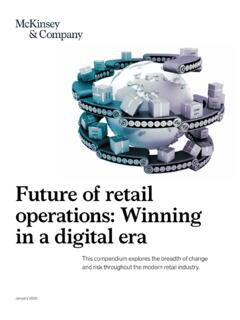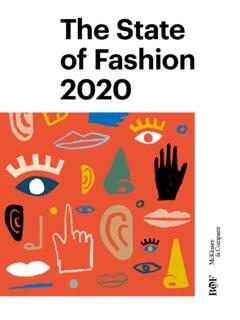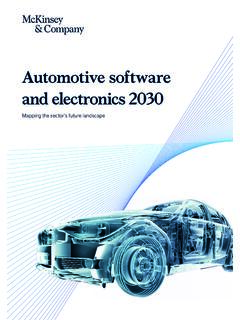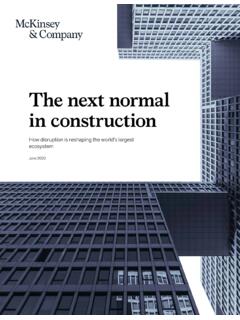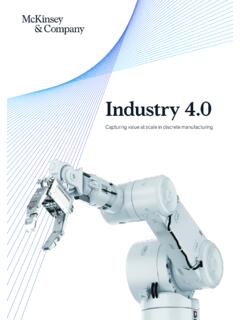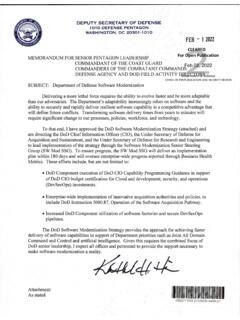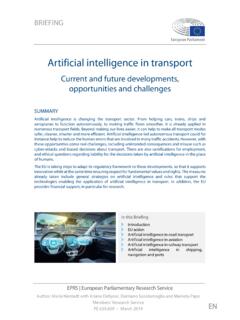Transcription of JOBS LOST, JOBS GAINED: WORKFORCE TRANSITIONS IN A …
1 JOBS LOST, JOBS GAINED: WORKFORCE TRANSITIONS . IN A TIME OF AUTOMATION. DECEMBER 2017. Since its About MGI. founding in 1990, the McKinsey Global Institute (MGI) has sought to develop a deeper understanding of the evolving global economy. As the business and economics research arm of McKinsey & Company, MGI aims to provide leaders in the commercial, public, and social sectors with the facts and insights on which to base management and policy decisions. The Lauder Institute at the University of Pennsylvania has ranked MGI the world's number- one private-sector think tank in its Think Tank Index. MGI research combines the disciplines of economics and management, employing the analytical tools of economics with the insights of business leaders. Our micro-to-macro methodology examines microeconomic industry trends to better understand the broad macroeconomic forces affecting business strategy and public policy. MGI's in-depth reports have covered more than 20 countries and 30 industries.
2 Current research focuses on six themes: productivity and growth, natural resources, labor markets, the evolution of global financial markets, the economic impact of technology and innovation, and urbanization. Recent reports have assessed the digital economy, the impact of AI and automation on employment, income inequality, the productivity puzzle, the economic benefits of tackling gender inequality, a new era of global competition, Chinese innovation, and digital and financial globalization. MGI is led by three McKinsey & Company senior partners: Jacques Bughin, Jonathan Woetzel, and James Manyika, who also serves as the chairman of MGI. Michael Chui, Susan Lund, Anu Madgavkar, Sree Ramaswamy, and Jaana Remes are MGI partners, and Jan Mischke and Jeongmin Seong are MGI senior fellows. Project teams are led by the MGI partners and a group of senior fellows, and include consultants from McKinsey offices around the world. These teams draw on McKinsey's global network of partners and industry and management experts.
3 Advice and input to MGI research are provided by the MGI Council, members of which are also involved in MGI's research. MGI council members are drawn from around the world and from various sectors and include Andr s Cadena, Sandrine Devillard, Richard Dobbs, Tarek Elmasry, Katy George, Rajat Gupta, Eric Hazan, Eric Labaye, Acha Leke, Scott Nyquist, Gary Pinkus, Sven Smit, Oliver Tonby, and Eckart Windhagen. In addition, leading economists, including Nobel laureates, act as research advisers to MGI research. The partners of McKinsey fund MGI's research; it is not commissioned by any business, government, or other institution. For further information about MGI. and to download reports, please visit Copyright McKinsey & Company 2017. JOBS LOST, JOBS GAINED: WORKFORCE TRANSITIONS . IN A TIME OF AUTOMATION. DECEMBER 2017. James Manyika | San Francisco Susan Lund | Washington, DC. Michael Chui | San Francisco Jacques Bughin | Brussels Jonathan Woetzel | Shanghai Parul Batra | San Francisco Ryan Ko | Silicon Valley Saurabh Sanghvi | Silicon Valley PREFACE.
4 Automation is not a new phenomenon, and fears about its transformation of the workplace and effects on employment date back centuries, even before the Industrial Revolution in the 18th and 19th centuries. In the 1960s, US President Lyndon Johnson empaneled a National Commission on Technology, Automation, and Economic Progress. Among its conclusions was the basic fact that technology destroys jobs, but not work. * Fast forward and rapid recent advances in automation technologies, including artificial intelligence, autonomous systems, and robotics are now raising the fears anew and with new urgency. In our January 2017 report on automation, A future that works: Automation, employment, and productivity, we analyzed the automation potential of the global economy, the timelines over which the phenomenon could play out, and the powerful productivity boost that automation adoption could deliver. This report goes a step further by examining both the potential labor market disruptions from automation and some potential sources of new labor demand that will create jobs.
5 We develop scenarios that seek to address some of the questions most often raised in the public debate. Will there be enough work in the future to maintain full employment, and if so what will that work be? Which occupations will thrive, and which ones will wither? What are the potential implications for skills and wages as machines perform some or the tasks that humans now do? The report is part of the McKinsey Global Institute's research program on the future of work, and is by no means the final word on this topic. The technology continues to evolve, as will our collective understanding of the economic implications. Indeed, we highlight some of the limitations of our analysis and scenarios, and areas for further research. The report builds on our previous research on labor markets, incomes, skills, and the expanding range of models of work, including the gig economy, as well as the potential impacts on the global economy of digitization, automation, robotics, and artificial intelligence.
6 The research was led by James Manyika, chairman and director of the McKinsey Global Institute and McKinsey senior partner based in San Francisco; Susan Lund, an MGI partner based in Washington, DC; Michael Chui, an MGI partner in San Francisco; Jacques Bughin, MGI director and McKinsey senior partner based in Brussels; and Jonathan Woetzel, MGI director and McKinsey senior partner in Shanghai. Parul Batra, Ryan Ko, and Saurabh Sanghvi headed the research team at different times over the course of the project. The team comprised Julian Albert, Gurneet Singh Dandona, Nicholas Fletcher, Darien Lee, Nik Nayar, Sonia Vora, and Rachel Wong. We are deeply grateful to our academic advisers, who challenged our thinking and provided valuable feedback and guidance throughout the research. We thank Richard N. Cooper, Maurits C. Boas Professor of International Economics at Harvard University; Sir Christopher Pissarides, Nobel laureate and Regius Professor of Economics at the London School of Economics; Michael Spence, Nobel laureate and William R.
7 Berkley Professor in Economics and Business at the NYU Stern School of Business; and Laura Tyson, Professor of Business Administration and Economics at the Haas School of Business, University of California, Berkeley. *. Technology and the American economy: Report of the National Commission on Technology, Automation, and Economic Progress, US Department of Health, Education, and Welfare, February 1966. Colleagues from around the world offered valuable insights into various aspects of our research. We thank Jens Riis Anderson, Jake Bryant, Richard Dobbs, Rajat Gupta, Kimberly Henderson, Tasuku Kuwabara, Meredith Lapointe, Jan Mischke, Anu Madgavkar, Deepa Mahajan, Mona Mourshed, Chandrika Rajagopalan, Jaana Remes, Jimmy Sarakatsannis, Katharina Schumacher, Jeongmin Seong, Bob Sternfels, and Eckart Windhagen. We are also grateful to the following McKinsey colleagues who provided technical advice and analytical support: Peter Aagaard, Jonathan Ablett, Rohit Agarwal, Tarun Agarwal, Moinak Bagchi, Drew Baker, Sergio Balcazar, Tim Beacom, Shannon Bouton, Leon Chen, Debadrita Dhara, Eduardo Doryan, Alan FitzGerald, Isabelle Fisher, Sarah Forman, Boyan Gerasimov, Enrique Gonzalez, Nicolas Grosman, Jose Mora Guerrero, Shishir Gupta, Fernanda Hernandez, Shumi Jain, Frederik Jensen, Karen Jones, Priyanka Kamra, Arpit Kaur, Mekala Krishnan, Priyanka Kumar, Krzysztof Kwiatkowski, Alison Lai, Freya Li, Mike Munroe, Jesse Noffsinger, Emilio Noriega, Erik Rong, Martin Schultz- Nielsen, Narasimhan Seshadri, Raman Sharma, Vivien Singer, Rachel Valentino, Charlotte van Dixhoorn, Jerry van Houten, Mike Wang, Wendy Wong, Hank Yang, and Desmond Zheng.
8 This report was edited and produced by MGI senior editor Peter Gumbel, editorial production manager Julie Philpot, senior graphic designers Marisa Carder, Margo Shimasaki, and Patrick White, and data visualization editor Richard Johnson. Rebeca Robboy, MGI director of external communications, managed dissemination and publicity, while digital editor Lauren Meling provided support for online publication and social media. We thank Deadra Henderson, MGI's manager of personnel and administration, for her support. This report contributes to MGI's mission to help business and policy leaders understand the forces transforming the global economy, identify strategic locations, and prepare for the next wave of growth. As with all MGI research, this work is independent and has not been commissioned or sponsored in any way by any business, government, or other institution. While we are grateful for all the input we have received, the report and views expressed here are ours alone.
9 We welcome your comments on this research at Jacques Bughin Director, McKinsey Global Institute Senior Partner, McKinsey & Company Brussels James Manyika Chairman and Director, McKinsey Global Institute Senior Partner, McKinsey & Company San Francisco Jonathan Woetzel Director, McKinsey Global Institute Senior Partner, McKinsey & Company Shanghai December 2017. On Fifth Avenue, New York Mitchell Funk/Photographer's Choice/Getty Images CONTENTS. HIGHLIGHTS In brief 33 Summary of findings Page 1. 1. Jobs lost, jobs changed: Impact of automation on work History's lessons Page 23. 87. 2. Lessons from history on technology and employment Page 33. 3. Jobs gained: Scenarios for employment growth Middle-wage conundrum Page 55. 106. 4. Implications for skills and wages Page 77. The future of work by country The retraining challenge Page 91. China 92. Germany 94. India 96. Japan 98. Mexico 100. United States 102. 5. Managing the WORKFORCE TRANSITIONS Page 105.
10 6. Priorities for government, business, and individuals Page 123. Technical appendix Page 131. Bibliography Page 143. IN BRIEF. JOBS LOST, JOBS GAINED: WORKFORCE . TRANSITIONS IN A TIME OF AUTOMATION. In our latest research on automation, we examine work Even if there is enough work to ensure full employment that can be automated through 2030 and jobs that may by 2030, major TRANSITIONS lie ahead that could match be created in the same period. We draw from lessons or even exceed the scale of historical shifts out of from history and develop various scenarios for the future . agriculture and manufacturing. Our scenarios suggest While it is hard to predict how all this will play out, our that by 2030, 75 million to 375 million workers (3 to research provides some insights into the likely WORKFORCE 14 percent of the global WORKFORCE ) will need to switch TRANSITIONS that should be expected and their implications. occupational categories. Moreover, all workers will Our key findings: need to adapt, as their occupations evolve alongside increasingly capable machines.
